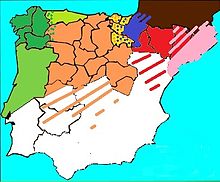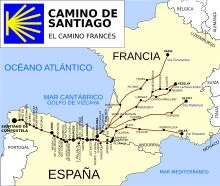

Spanish Romanesque designates the Romanesque art developed in the Hispanic-Christian kingdoms of the Iberian Peninsula in the 11th and 12th centuries. Its stylistic features are essentially common to the European Romanesque although it developed particular characteristics in the different regions of the peninsula. There is no Romanesque art in the southern half of the peninsula because it remained under Muslim rule (Al-Andalus). The examples of Romanesque buildings in the central area of the peninsula are sparse and of the latest period, with virtually no presence south of the Ebro and the Tagus. Most Romanesque buildings can be found in the northern third of the peninsula. Romanesque art was introduced into the peninsula from east to west, so scholars have usually defined regional characteristics accordingly: the "eastern kingdoms" comprising the Pyrenean areas, Catalan Romanesque, Aragonese Romanesque and Navarrese Romanesque, and the "western kingdoms" comprising Castilian-Leonese Romanesque, Asturian Romanesque, Galician Romanesque and Portuguese Romanesque.
The First Romanesque or Lombard Romanesque is specially present in Catalonia, while the full Romanesque spread from the foundations of the Order of Cluny along the axis of the Camino de Santiago. The late-romanesque of the 13th century, can be found specially in rural buildings.[1]
- ^ Antonio Fernández, Emilio Barnechea and Juan Haro, History of Art, Barcelona: Vicens-Vives, 1992, ISBN 9788431625542, cp. 9, pg. 145-165.